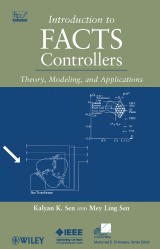Details

Introduction to FACTS Controllers
Theory, Modeling, and ApplicationsIEEE Press Series on Power and Energy Systems, Band 54 1. Aufl.
|
136,99 € |
|
| Verlag: | Wiley |
| Format: | |
| Veröffentl.: | 13.10.2009 |
| ISBN/EAN: | 9780470524732 |
| Sprache: | englisch |
| Anzahl Seiten: | 544 |
DRM-geschütztes eBook, Sie benötigen z.B. Adobe Digital Editions und eine Adobe ID zum Lesen.
Beschreibungen
<p>Demystifies FACTS controllers, offering solutions to power control and power flow problems</p> <p>Flexible alternating current transmission systems (FACTS) controllers represent one of the most important technological advances in recent years, both enhancing controllability and increasing power transfer capacity of electric power transmission networks. This timely publication serves as an applications manual, offering readers clear instructions on how to model, design, build, evaluate, and install FACTS controllers. Authors Kalyan Sen and Mey Ling Sen share their two decades of experience in FACTS controller research and implementation, including their own pioneering FACTS design breakthroughs.</p> <p>Readers gain a solid foundation in all aspects of FACTS controllers, including:</p> <ul> <li> <p>Basic underlying theories</p> </li> <li> <p>Step-by-step evolution of FACTS controller development</p> </li> <li> <p>Guidelines for selecting the right FACTS controller</p> </li> <li> <p>Sample computer simulations in EMTP programming language</p> </li> <li> <p>Key differences in modeling such FACTS controllers as the voltage regulating transformer, phase angle regulator, and unified power flow controller</p> </li> <li> <p>Modeling techniques and control implementations for the three basic VSC-based FACTS controllers—STATCOM, SSSC, and UPFC</p> </li> </ul> <p>In addition, the book describes a new type of FACTS controller, the Sen Transformer, which is based on technology developed by the authors. An appendix presents all the sample models that are discussed in the book, and the accompanying FTP site offers many more downloadable sample models as well as the full-color photographs that appear throughout the book.</p> <p>This book is essential reading for practitioners and students of power engineering around the world, offering viable solutions to the increasing problems of grid congestion and power flow limitations in electric power transmission systems.</p>
Foreword. <p>Preface.</p> <p>Acknowledgements.</p> <p>Nomenclature.</p> <p><b>1. Applications of FACTS Controllers.</b></p> <p><b>2. Power Flow Control Concepts.</b></p> <p>2.1 Theory.</p> <p>2.2 Implementation of Power Flow Control Concepts.</p> <p>2.3 Interline Power Flow Concept.</p> <p><b>3. Modeling Principles.</b></p> <p>3.1 The Modeling in EMTP.</p> <p>3.2 Vector Phase-Locked Loop (VPLL).</p> <p>3.3 Transmission Line Steady-State Resistance Calculator.</p> <p>3.4 Simulation of an Independent PFC in a Single Line Application.</p> <p><b>4. Transformer-Based FACTS Controllers.</b></p> <p>4.1 Voltage Regulating Transformer (VRT).</p> <p>4.2 Phase Angle Regulator (PAR).</p> <p><b>5. Mechanically Switched FACTS controllers.</b></p> <p>5.1 Shunt Compensation.</p> <p>5.2 Series Compensation.</p> <p><b>Chapter 6: Voltage-Sourced Converter (VSC).</b></p> <p>6.1 Modeling an Ideal VSC.</p> <p>6.2 DC-to-AC VSC.</p> <p>6.3 Discussion.</p> <p><b>7. Two-Level Pole Design.</b></p> <p>7.1 A Three-Phase, Six-Pulse VSC with Two-Level Poles.</p> <p>7.2 Analysis of a Pole.</p> <p><b>8. VSC-Based FACTS Controllers.</b></p> <p>8.1 Shunt Compensation.</p> <p>8.2 Series Compensation.</p> <p>8.3 Shunt-Series Compensation Using a Unified Power Flow Controller (UPFC).</p> <p><b>9. Sen Transformer.</b></p> <p>9.1 Existing Solutions.</p> <p>9.2 Desired Solution.</p> <p>9.3 Comparison Among the VRT, PAR, UPFC, and ST.</p> <p>9.4 Multiline Sen Transformer.</p> <p>9.5 Flexible Operation of the ST.</p> <p>9.6 ST with Shunt-Connected Compensating Voltages.</p> <p>9.7 Limited Angle Operation of the ST with Shunt-Connected Compensating Voltages.</p> <p>9.8 MST with Shunt-Connected Compensating Voltages.</p> <p>9.9 Generalized Sen Transformer.</p> <p>9.10 Summary.</p> <p>Appendix A. Miscellaneous.</p> <p>Appendix B. Power Flow Control Equation in a Lossy Transmission Line.</p> <p>Appendix C. EMTP Files.</p> <p>Bibliography.</p> <p>Index.</p> <p>About he Authors.</p>
<b>Kalyan K. Sen, PhD, PE,</b> was a key member of the FACTS development team at Westinghouse Science & Technology Center, where he developed some of the basic concepts of FACTS technology. With more than twenty years of experience in academia and industry, he has twenty-five patents and publications in the areas of FACTS and power electronics. He served as the technical program chair of the 2008 Power & Energy Society General Meeting. He has been serving as an IEEE Distinguished Lecturer since 2002. <p><b>Mey Ling Sen, Mee,</b> was a consultant engineer at the Westinghouse Electro-Mechanical Division Technology Center. Currently, she is the President of SEN Engineering Solutions. Ms. Sen is the co-inventor of the Sen transformer, which is the most efficient, reliable, and cost-effective FACTS controller.</p>
<p>Demystifies FACTS controllers, offering solutions to power control and power flow problems</p> <p>Flexible alternating current transmission systems (FACTS) controllers represent one of the most important technological advances in recent years, both enhancing controllability and increasing power transfer capacity of electric power transmission networks. This timely publication serves as an applications manual, offering readers clear instructions on how to model, design, build, evaluate, and install FACTS controllers. Authors Kalyan Sen and Mey Ling Sen share their two decades of experience in FACTS controller research and implementation, including their own pioneering FACTS design breakthroughs.</p> <p>Readers gain a solid foundation in all aspects of FACTS controllers, including:</p> <ul> <li> <p>Basic underlying theories</p> </li> <li> <p>Step-by-step evolution of FACTS controller development</p> </li> <li> <p>Guidelines for selecting the right FACTS controller</p> </li> <li> <p>Sample computer simulations in EMTP programming language</p> </li> <li> <p>Key differences in modeling such FACTS controllers as the voltage regulating transformer, phase angle regulator, and unified power flow controller</p> </li> <li> <p>Modeling techniques and control implementations for the three basic VSC-based FACTS controllers—STATCOM, SSSC, and UPFC</p> </li> </ul> <p>In addition, the book describes a new type of FACTS controller, the Sen Transformer, which is based on technology developed by the authors. An appendix presents all the sample models that are discussed in the book, and the accompanying FTP site offers many more downloadable sample models as well as the full-color photographs that appear throughout the book.</p> <p>This book is essential reading for practitioners and students of power engineering around the world, offering viable solutions to the increasing problems of grid congestion and power flow limitations in electric power transmission systems.</p>

















